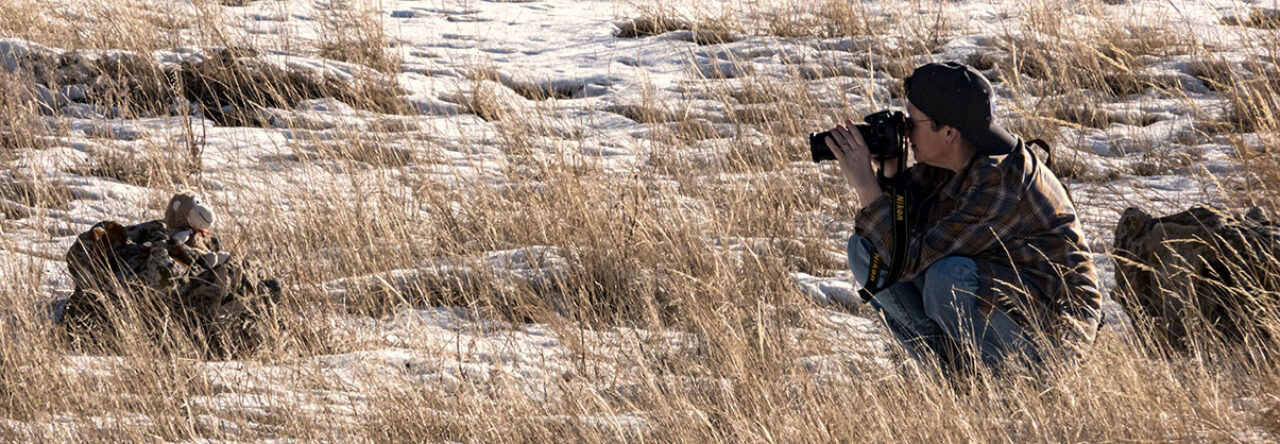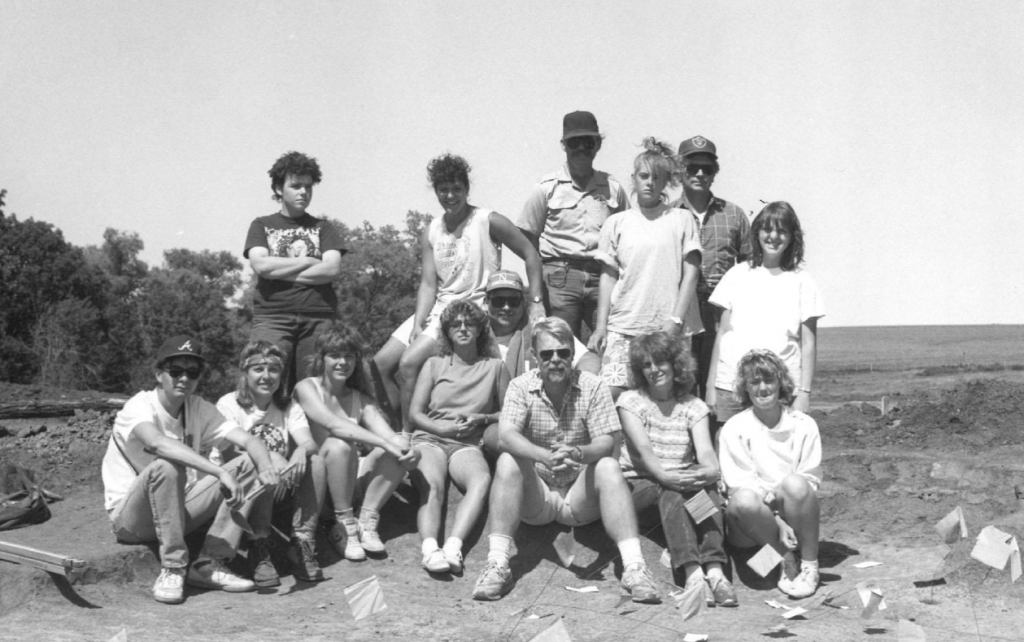I carefully used the point of my trowel to flick away a piece of dirt from the artifact. After I had scraped enough large pieces of dirt with the trowel, I reached over to my kit and grabbed my brush. It wasn’t yet clear what the artifact was, so I gently moved the brush back and forth, clearing away the dirt to get a better sense of what I had found.
“What’d ya find?” Russ said.
“Not exactly sure yet,” I said.
“Pottery fragment?” he said.
“Possibly,” I said.
I brushed more dirt away. The fragment had a rounded edge to it, so it didn’t appear to be bone. Eventually, I had carefully brushed away enough dirt I could start cataloging the artifact.
“Need some help with the drawing?” he said.
“Most definitely,” I said.
Before removing an artifact from where you find it, its location must be logged, drawn, and photographed. Logging and photographing I can do. Drawing, not so much.
Russ grabbed a photo scale and placed it next to the artifact. Just as I grabbed the book to begin writing its location, Professor Bleed yelled for us all to gather together. We were going to have our picture taken for the archives.
I don’t like having my picture taken. It comes from years of being made fun of about the way I look and so I shy away from cameras. The photograph above is one of the few pictures of me I like. It was taken during the summer of 1989 with my Anthropology classmates.
The University of Nebraska-Lincoln offered an eight-week summer session class with hands-on training in archaeology. Class size was limited and the professor chose who was allowed into the class. I was pleased that, as a freshman, I was one of 12 students chosen. We were supposed to participate in a dig at the Battle of the Greasy Grass, also known as the Battle of the Little Bighorn. Some political stuff intervened and that didn’t happen.
Instead, we were asked to work with archaeologists at the Nebraska State Historical Society. A new highway was being laid somewhere near Seward and remnants of a Plains Indians settlement had been found. There was a legal time limit as to how long construction would be stopped. The Historical Society had just a few weeks to gather what they could and asked us to help, which increased their chances of finding vital information.
The work I did on the dig allowed me to keep my mind off of other things that plagued my mind. In 1989, if you heard the words PTSD and flashbacks, it was always related to a veteran. I didn’t know that’s what I was experiencing. I would have never made the connection because I was about to turn 19 years old and had never been in a war zone. They were just terrible memories and nightmares that sometimes happened when I was awake.
I used alcohol and marijuana, and a variety of other bad coping skills, to keep living. They both numbed my brain so I could get some sleep, but I was still often sleep-deprived.
While I was dealing with the memories in my head, my time on the dig was a respite from everything I was doing to make it to the next day. My first year of college was difficult. My mom could barely afford to send me to college. There were no cell phones. It would be five years before I first logged onto the internet. I didn’t call home a lot. Phone calls were expensive, so I only called when necessary. I was halfway across the country, alone, and quietly suffering. I couldn’t explain what was happening to myself, yet alone to anyone else. I tried to do everything on my own.
My mother sent me $25 a month spending money, which also needed to be used for Sunday dinners. We couldn’t afford the 20-meal plan at the university. I had the 13-meal plan – lunch and dinner each day and no Sunday dinner. Lunch in the dorms included hot dogs and hamburgers. I often stole extra hot dogs and put them in my left pants pocket to keep for Sundays so I didn’t go hungry. I didn’t have to worry about paying for alcohol. I wrote college papers in exchange for Courvoisier cognac. Others let me smoke pot for free.
The dig, however, was a peaceful calm in the storm of my life. It let me focus on the task at hand for 8-10 hours a day. I didn’t know it at the time, but it was a pretty good coping skill.
I enjoyed surface archaeology while out in the field. Most of my classmates did not, but there’s a oneness, a feeling of unity with the universe when you walk, head toward the ground, searching for remnants of the past that remain on the surface. For most, it’s a boring and tedious, yet necessary, part of the job. For me, it was a great joy. I was contributing to society, to history, and I felt useful.
We eventually found a cache pit, which is basically where garbage was tossed. Your garbage today will be a goldmine in hundreds of years to archaeologists. Myself and one other classmate could fit in it. She hated surface archaeology and I didn’t enjoy the closed in space of sitting in a pit with only one exit that could collapse at any time. She found far cooler objects than me and that’s okay. I got to breathe and be by myself while still doing my work.
We were all told we could keep the first artifact we found. Almost everyone found an arrowhead. I found an intact pot handle. I wasn’t allowed to keep it. I was told the historical society did not have one and it was too valuable. I was offered an arrowhead instead. I declined.
On the way back to Lincoln each day, I stared out the van window. I constantly shifted my focus on what was outside. Sometimes, I was inside my head desperately trying to stop a flashback. It still happens today. If you ever see me in public and I seem to be spacing off, I’m probably in my head cycling through all the things I need to do to stay grounded in reality. The difference today is I know what’s happening to me.
The photograph was taken sometime during the last week of our time in the field, around my 19th birthday, before we moved on to downtown Lincoln. If you’ve been in the Haymarket and stood in the square where the mini water tower is, know that in July, 1989 I was there digging. That area used to hold a small building where conductors would sleep.
I didn’t know the photograph was going to be taken that day. I doubt I would have dressed any differently. I wore black jeans and my black, Robert Plant t-shirt often. My hair went that way naturally. It was naturally curly and I rarely used a comb – I would just run my fingers through my hair a few times after a shower and I was good to go. I didn’t really care if anyone else liked it.
Like with many things in my life, I cannot remember the exact day the picture was taken, but I know how I felt. If you’re an armchair psychologist, you’re probably right about everything about me in that picture. I was a bit crabby because I had to pose in the picture. I don’t like having my picture taken and I was upset that I had to stop working for a damned photo.
We also spent time in the lab, cleaning, cataloging, and labeling artifacts. Most of my classmates didn’t like the work, but, again, I loved it. I spent nearly every semester of college in the lab working with artifacts. I enjoyed the texture of each one, cleaning the dirt off each artifact, and placing it, with its new catalog label, back into its proper place in its proper box for study later. It was quiet in the lab. No one bothered me. It was a safe place for me on campus.
After we had finished our class, one of my classmates threw a party at her apartment. I didn’t want to go. I was one of two freshman in the class. The rest of my colleagues were over 21. Although I had been out to the bars with them, I never really felt like I fit in. The party was another awkward experience. It was also during a bad time where I wasn’t sleeping and was trying to forget all the terrible things in my head.
The problem with a party with unlimited booze was I had, and have, an extremely high tolerance for alcohol. It’s a gene I most likely inherited from my grandmother. When I was little, the only time I saw her drink was one year during the annual family Christmas party. My older cousin wanted to show off and claimed he could drink her under the table. He lost.
This party was the first time I experienced being conscious, but not being able to see. I ended up sitting on a couch. Several people talked to me. None of them knew all I could see was black. I had sat down with several drinks. I drank them and eventually fell asleep. It was nice only because I didn’t have a nightmare. I didn’t have a flashback. I didn’t relive any of the terrible memories that always bubbled to the surface when I slumbered.
I don’t remember how I got home. I know I trusted my classmates enough to get me home safely. I was a little sister at Acacia Fraternity and I had rented one of their rooms for the summer, which I shared with another classmate.
In April 2019, archaeologists from the State Historical Society came out to the Chimney Rock National Historical Site. I spent the day with them. Naturally, I took a lot of photographs.
The best part of the day was being able to converse on a topic I knew. I didn’t have to ask dumb questions about what they were doing because I already knew and understood. I could spend my time discussing why they were there and the importance of surveying the area.
I spent about nine hours with the state archaeologists. About 20 minutes was a discussion about my time helping the historical society during the Summer of 1989. I didn’t think much of it and continued my work for the article.
About six months later, the picture at the top of this post was sent to me. One of the archaeologists had taken the time to go through the archives to find it and send it to me. I was overwhelmed that someone I barely knew thought enough to do this for me.
The picture means a lot to me – more than I can explain adequately in words.
As Ambassador Delenn said in the television series Babylon 5, “The universe puts us in places where we can learn. They are never easy places, but they are right. Wherever we are is the right place and the right time. The pain that sometimes comes is part of the process of constantly being born.”
Though it was a difficult summer for me, the picture captured a moment in time, a moment of transition, a moment of remembrance of somewhat peaceful days that helped me to keep going and hope something better would come.


Jina Red Nest
Ahhh, you did it again ! i just wuv your stories, ok “love” they’re so descriptive and interesting. Ver-very interesting and thank you for sharing that picture but I have seen it someplace before…